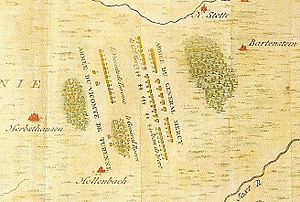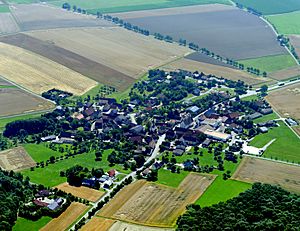Battle of Herbsthausen facts for kids
Quick facts for kids Battle of Herbsthausen |
|||||||
|---|---|---|---|---|---|---|---|
| Part of Thirty Years' War | |||||||
 Battle of Mergentheim (“Mariendal” in the drawing), or Battle of Herbsthausen, of 1645. Plan of action, French depiction. |
|||||||
|
|||||||
| Belligerents | |||||||
| Commanders and leaders | |||||||
| Franz von Mercy Johann von Werth |
Vicomte de Turenne Reinhold von Rosen (POW) |
||||||
| Strength | |||||||
| 9,650 total 4,300 infantry, 5,300 cavalry, 9 guns |
6,000 men | ||||||
| Casualties and losses | |||||||
| 600 killed and wounded | 4,400 killed, wounded and captured | ||||||
The Battle of Herbsthausen, also called the Battle of Mergentheim, was a big fight during the Thirty Years' War. It happened on May 5, 1645, near a town called Bad Mergentheim in what is now Germany. In this battle, a French army led by Turenne was defeated by a Bavarian army. The Bavarian forces were commanded by Franz von Mercy.
Just a few months before, in February 1645, the Bavarians had sent many of their best cavalry soldiers to help another army. Most of these soldiers were lost in a big defeat called the Battle of Jankau. Because of this, Mercy waited until he had enough troops again. Then, he surprised Turenne's army at Herbsthausen. The French soldiers, many of whom were new recruits, quickly broke apart. They lost over 4,400 men, while the Bavarians lost only 600.
Even though Mercy won, he couldn't gain a big advantage in the war. He was killed later that year in August. Fighting continued for a while, but both sides realized they couldn't win completely by fighting. So, they started talking about peace more seriously. These talks eventually led to the Peace of Westphalia in 1648, which ended the Thirty Years' War.
Contents
Why the Battle Happened
The Thirty Years' War started in 1618. It began when a group of Protestant nobles in Bohemia offered their crown to Frederick V of the Palatinate. They did not want the Catholic Emperor Ferdinand II to rule them. At first, many parts of the Holy Roman Empire stayed out of the fight. The revolt was quickly put down.
War Changes and New Players
The war changed when Maximilian of Bavaria, a Catholic, took over the Palatinate. This area was very important for military control. This change brought more Protestant German states into the war. Countries like Denmark-Norway also joined. In 1630, Gustavus Adolphus of Sweden invaded a region called Pomerania. He wanted to help Protestants and control the Baltic Sea trade. This trade was a big source of money for Sweden.
Even after Gustavus Adolphus died in 1632, Sweden kept fighting. But their goals started to clash with other Protestant states in Germany. After Sweden lost a major battle in 1634, many of their German allies made peace. This was the Treaty of Prague in 1635. The war then became less about religion. It turned into a fight between the Habsburg emperors and France. France was supported by Sweden and George Rákóczi, a prince from Transylvania. This was part of a long-standing rivalry between these powerful families.
Plans for Peace and More Fighting
Ferdinand III became emperor in 1637. He agreed to peace talks in 1643. However, he secretly told his diplomats to delay. He still hoped to win the war by fighting. In 1644, the Swedes defeated the Danes. The Danes had joined the war as an ally of the Emperor. Then, the Swedes destroyed an Imperial army in Saxony.
Even though the Bavarians won a battle at Freiburg in August 1644, they couldn't stop the French. The French captured Philippsburg and took over Lorraine. Mercy, the Bavarian commander, moved his army to Heilbronn for the winter.
In 1645, the Swedish commander Lennart Torstensson suggested a plan. He wanted to attack Vienna, the capital of the Holy Roman Empire. This would force Ferdinand III to agree to peace. The plan was for the French to go into Bavaria. Rákóczi would join the Swedes in Bohemia. Then, they would all move towards Vienna. Mercy sent 5,000 of his best Bavarian cavalry to help the Imperial army in Bohemia. But this army was badly beaten at Jankau on March 6.
Challenges of Supplying Armies
Armies back then needed to find their own food and supplies. This was for both the soldiers and their horses. By 1645, the countryside was ruined from years of war. Soldiers spent a lot of time just trying to find food. This made it hard to plan big military actions. It also affected the Battle of Herbsthausen. Turenne had spread out his army to find supplies. Because of this, 3,000 of his 9,000 soldiers didn't even make it to the battle. Many others arrived too late to help.
The Battle of Herbsthausen
After the victory at Jankau, the French thought they could knock Bavaria out of the war. The French chief minister, Cardinal Mazarin, ordered Turenne to fight the Bavarians. Mercy avoided Turenne until he had more soldiers. After a month of marching back and forth, the French army was tired and low on supplies. In mid-April, Turenne stopped. He spread his army between Rothenburg and Bad Mergentheim. He was waiting for more soldiers from Hesse-Kassel. Most of his experienced French soldiers had been lost in an earlier battle. Turenne didn't trust his new recruits yet.
Even though only 1,500 of Werth's 5,000 cavalry returned from Bohemia, Mercy gathered a strong force. He had 9,650 men and nine cannons at Feuchtwangen. He marched north on May 2. By the evening of May 4, they were very close to Herbsthausen. This was a small village near Bad Mergentheim. They met French cavalry patrols around 2:00 am. Turenne ordered his cavalry to the right side. The infantry, or foot soldiers, were placed along the edge of a wood. This wood overlooked the main road.
Turenne was caught by surprise. He couldn't even set up his cannons. Also, 3,000 of his 9,000 soldiers in the area didn't show up at all. The Bavarian cannons started firing. Splinters and branches from the trees made the cannon fire even more dangerous. Mercy then ordered a full attack. The inexperienced French infantry fired their guns too early. They panicked and ran away. Turenne led a cavalry charge. He scattered some of the Bavarian soldiers. He managed to escape with 150 other men. They reached Hanau in southern Hesse. The French infantry had to surrender. The soldiers in Mergentheim also surrendered. About 1,500 French cavalry were captured. The French commanders, Rosen and Schmidberg, were taken prisoner. In total, the French lost 4,400 men. The Bavarians lost only 600.
What Happened Next

Most historians today say Turenne was simply surprised. But many French writers in the 1800s blamed Rosen for the defeat. Rosen was described as a "better soldier than general." In 1647, Turenne even arrested Rosen for mutiny. He was only released after 14 months.
The victory at Herbsthausen made the Imperial army feel better after their defeat at Jankau. But it didn't change the overall situation much. Condé, a French general who won a big battle at Rocroi, took command of the French army. By early July, he had about 23,000 men.
Mercy returned to Heilbronn. He received 4,500 more men from Ferdinand of Cologne. This brought his army up to 16,000 soldiers. Mercy again showed how good he was at outsmarting his enemies. But on August 3, he was killed at the battle of Second Nördlingen. Even though the French won this battle, they also lost many soldiers. By the end of the year, they were back where they started. In September, the Swedes agreed to a six-month truce with John George of Saxony. Both sides realized that fighting couldn't solve the war. In October, they started peace negotiations again.
Sources


